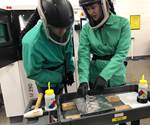Five Training Considerations for Additive Manufacturing
Hands-on courses at the UL AMCC cover factors important for success in AM.
Metal additive manufacturing has many variables—material, heat, part features, etc.—that can affect part quality. Achieving consistently good parts requires a process that regulates these variables as much as possible and an understanding of how they affect the final outcome.
The goal of the UL Additive Manufacturing Competency Center (UL AMCC) is to teach students how to set up a consistent, repeatable additive manufacturing process to achieve quality parts every time. The center, which held its grand opening earlier this year, offers hands-on courses in additive manufacturing for professional engineers, designers and technicians. Students produce their own AM metal parts as part of the coursework. In the process, they learn how to make their sample part successfully, but also how to set up a safe and effective additive manufacturing process.
For manufacturers considering additive manufacturing, the content of that training provides a helpful illustration of what mastering this capability entails. As indicated in this post on UL’s site, success with AM involves all of the following:
- Materials. Each course at UL starts with an in-depth review of metal powders, including safe handling procedures.
- Safety. In addition to how to handle metal powders, students learn how to manage risks across the entire AM process, from pre-production to clean up, including personal protection equipment (PPE) requirements.
- Design for additive manufacturing (DFAM). Students build their own parts during the courses for hands-on experience. While they are welcome to use designs developed by the center, many bring their own. Instructors review the designs for buildability, and help students think through considerations such as support structures that may be necessary.
- Machine setup and operation. Students perform each step in the AM process, including preparing build plates and running the machines.
- Postprocessing. Students separate completed parts from the build plates, remove support structures, and perform any polishing, finishing or other postprocessing required.
Related Content
-
How to Build 10,000+ Shot Molds in Hours
Rapid tooling isn’t so rapid when it takes days to 3D print a metal mold, and then you still must machine it to reach the necessary tolerances. With Nexa3D’s polymer process you can print a mold in hours that is prototype or production ready and can last for more than 10,000 shots.
-
AM 101: What is Ultrasonic Additive Manufacturing?
Going from additive to subtractive can be simple with Ultrasonic Additive Manufacturing (UAM). What is it and how does it work? Learn the basics in this 101 post.
-
Postprocessing Steps and Costs for Metal 3D Printing
When your metal part is done 3D printing, you just pull it out of the machine and start using it, right? Not exactly.

.jpg;width=70;height=70;mode=crop)










